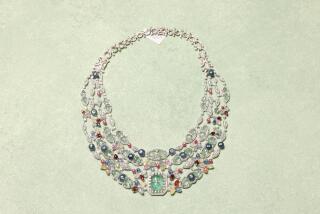Thai Gem Industry Gains Luster : Asia: Country curbed smuggling and shady deal making and saw exports of stones and gold jewelry reach $2 billion in 1994.
- Share via
BANGKOK, Thailand — Twenty years ago, the fledgling Thai gem industry was beset by police and customs agents trying to stem the flow of smuggled rubies and sapphires into the country. Times have changed.
From a business known for shadowy deals conducted on the fringes of the law, the Thai gem and jewelry industry is now a multibillion-dollar winner for the government.
By taking advantage of turmoil among its neighbors and strong official support, Thailand dominates the world market in gemstones and has launched a determined bid to grab a slice of the lucrative diamond and gold jewelry business.
“We started with nothing and worked so hard from zero,” said Pichait Palanugool, 49, vice president of the Beauty Gems Group, the country’s biggest gem company. “We had a lot of problems with police and customs. Now we are the No. 1 exporter of gemstones” in the world, with many of the gems and jewelry ending up in the United States.
Pichait said Beauty Gems is about to move its workers from a cramped factory in Bangkok to a gleaming new building across the road. He refused to say what the net income of the company was in 1994, but analysts place it at more than $50 million.
Thai gem and jewelry exports jumped 10% in 1994 to $2 billion, industry officials said. Exports are expected to rise to $4 billion by 2000, according to the Thai Gem and Jewelry Traders Assn.
The products sold by Thailand range from intricately designed necklaces set with diamonds or precious stones to earrings studded with glittering rubies. The main markets are the United States, Japan and Western Europe.
Jean-Michel Roux, manager of the stone-trading division of Swiss-based Golay Buchel, said Thailand enjoys an edge over other countries because it has its own mines and is near countries such as Cambodia and Myanmar that are prime sources of precious stones.
Analysts say decades of conflict in those two countries have knocked out any chance for them to develop their own gem and jewelry business, which could have competed with Thailand, forcing them to send most of their stones to Bangkok for cutting and polishing.
As a result, Thailand has developed a deep pool of workers adept at cutting and polishing precious stones to bolster its strong manufacturing base, Roux said.
“Our technicians are capable of performing their jobs in terms of creativity and efficiency as well as those in Belgium and Israel,” said Boonyong Assarasakorn, president of the Bangkok Diamonds and Precious Stones Exchange.
Beauty Gems has more than 800 employees who polish and put together a variety of jewelry sets.
A factory manager at Beauty Gems said many of the workers have been formally trained in gem-finishing schools and have an average of seven years’ experience.
Pongpan Pongsiribanyat, the country manager for the World Gold Council, said such a strong base for the gem trade has allowed Thailand to expand easily into the diamond and gold jewelry business.
After Bangkok replaced duties on gold imports with value-added taxes about three years ago, the gold jewelry industry took off.
Thailand faces competition from China and India but is likely to remain in the driver’s seat because the quality of its products tops that of its rivals, Roux said. Labor costs in China and India are lower than in Thailand, but craftsmanship remains a problem.
More to Read
Sign up for Essential California
The most important California stories and recommendations in your inbox every morning.
You may occasionally receive promotional content from the Los Angeles Times.












